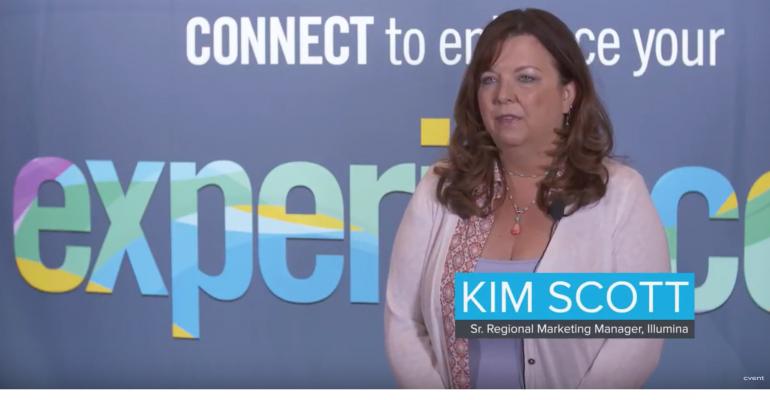“It’s not just brand marketing and education!” said Kim Scott, senior regional marketing manager at Illumina, Inc., at the beginning of her Cvent Connect session on supercharging event data. Scott reminded participants that meetings drive sales, and with the right approach to data, meeting planners and departments can get recognition for their role in the selling process.
Here are Scott’s four tips to show your efforts are paying off for the company:
1. Define Your Success
To measure their efforts, Scott directed session goers to the ROI Institute http://www.roiinstitute.net/ to find metrics that work in your industry.
Cost reduction: It is easier to keep a customer than get a new one, so measure how much education and support your meetings provide to current customers.
New contacts: Track every response to your campaigns and consider every contact at a new company to be an influencer in the buying process, even if they are not the purchasing decision maker.
2. Data Collection
Use multiple data sets. It is important to capture not just registration data and spend, but pre- and post-event surveys. Scott cautions against wasting your attendees’ time on questions about the food or air conditioning temperatures. Ask how the attendees felt. What did they learn? What did they want to learn? Did the information help them at work? Spend some time rethinking your questions to weed out anything unnecessary and encourage the most helpful responses. For example, Scott has been asked in questionnaires how many events she organizes a year, and the multiple choice options can be from 0 to 5, 5-10, 10-20, and so on. She asked the audience, “How much difference is there in product interest from planners who have 5-10 events a year or those how plan 10–20 events?” Answer: Not much. This type of granular information is only useful if you know how many attendees are at each event, and how many different venues are in play, and you won’t get this type of in-depth information from a pen and paper survey at the end of a session. Scott suggests that an electronic survey might be more useful for multiple if/then questions, and she likes to “reward” onsite survey participants. She says, “We hold our swag for ransom!”
3. Data Analysis
Scott described two factors to consider before you can properly analyze your data: the sales cycle and account mapping.
Every sales cycle has peaks and troughs that coincide with your customers’ internal budget logic, and if you don’t understand them, you won’t be able to ascribe the impact of your event appropriately. It takes time to get approval for large sales, and sometimes customers need to wait for a new fiscal year before adding major expenditures to the books.
Account mapping data will help you show the impact of your event. Using Illumina as an example, Scott said that a customer can have 20 employees who are all influencers, and nine of them may attend one of her events, but because the salesperson only interacts with one person on the account, the meeting component is not viewed as a contribution to the sale. By capturing information about all your attendees, and mapping it to all your accounts, you can show the role your event played in the purchase decision.
4. Partnering with Sales
Ask yourself if the sales department is working with you or without you. One way to measure this is “opportunity consistency” results. Scott gave the example of a road trip her department organized through 58 cities to give an instrument demonstration. Each city had the same content, and almost identical venues, catering, and schedule. When they measured the totals for each city, one event translated into $1,500 in sales while another produced $5 million. The only difference was the sales team. This type of data can be used to demonstrate that events are a major factor in closing millions of dollars in sales, and perhaps also show that some sales teams are not taking advantage of the opportunities you are providing them.
There are a number of reasons why a sales team might be reluctant to buy-in to your events and prefer to produce smaller ones themselves, rather than share information. Scott said the main reason is often “sandbagging,” where a salesperson doesn’t share a lead because they don’t want pressure from the company to convert it to a sale. They prefer to produce greater-than-anticipated results. Unfortunately, this can result in poorly produced events with a low return on investment, and that can undermine your department as well as the whole concept of in-person meetings and events.
To combat any lack of cooperation from your company’s sales department, Scott suggested a carrot-and-stick approach. The carrot would be to offer to work with them to produce more polished events, and then capture the attendee registration data yourself. The stick would be to withhold your marketing budget from events outside your department, and to force them to comply with healthcare provider financial reporting (required of medical companies) on their own. Not only are regulations a headache to deal with, even accidental noncompliance can result in fines and penalties.
Finally, Scott advised having patience. She pointed out that although data can and, when appropriate, should be collected in real time, analyzing and releasing the data too soon can hide the true impact of your marketing and education efforts on sales. Scott’s company manufactures tools for analyzing DNA, and the products are expensive and often require a lengthy approval process from the buyer before a sale is closed. By capturing the data for each touchpoint the events department has with influencers and buyers, sometimes over months or even years, they can build a convincing case for the role of events in any eventual sale.





